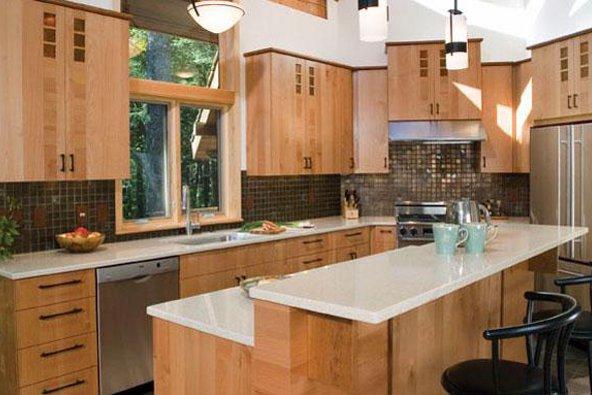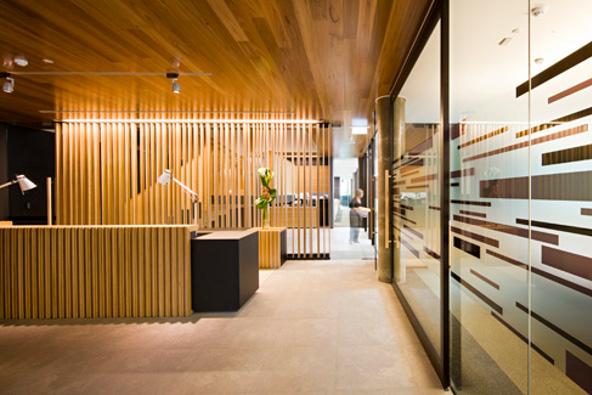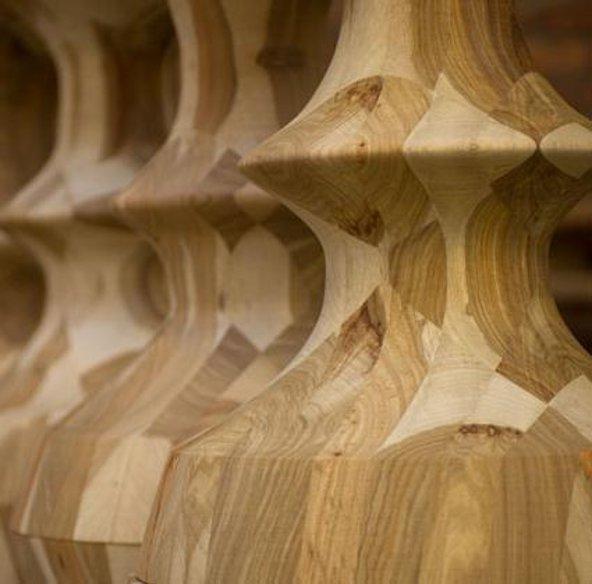Yellow walnut is an Australian native hardwood timber species. Very limited quantities are still used for a variety of decorative and construction purposes.
Canary Ash, Yellow Nut
Beilschmiedia bancroftii
Yellow walnut is a well-shaped, medium-sized tree, attaining a maximum height of 25 to 30 metres. It occurs in North Queensland rainforests around the Johnstone and Russell Rivers, Evelyn and Daintree Rivers, Bellenden Ker Range and the Atherton Tableland. Commercial availability of yellow walnut timber is currently very limited, due to enforced conservation of the rainforests in which it typically occurs.
The heartwood of this species is pale to bright lemon yellow in colour. Sapwood is typically paler but often difficult to distinguish from the true wood, since it can occupy up to 50% of the stem radius. Grain is straight and moderately coarse, with little or no figure - although back-sawn surfaces may occasionally show figure due to earlywood/latewood ring formation.
In terms of durability, yellow walnut is a class 4 hardwood, with a maximum life expectancy of between five and seven years (aboveground and in-ground application, respectively). The sapwood (but not heartwood) of this species is readily impregnated with preservatives using commercially available procedures. Untreated sapwood is susceptible to borer attack. Yellow walnut is not resistant to termites.
Common applications of yellow walnut range from light construction (as sawn timber in general house framing, flooring, linings and mouldings) to a variety of decorative uses (plywood, furniture, joinery, turnery, carving and paneling).
Shrinkage
| Very Low | Low | Medium | High | Very High | |
|---|---|---|---|---|---|
|
|
|
||||
|
Tangential :
|
3.80% | ||||
|
Radial :
|
2.10% | ||||
|
Unit Movement Tangential:
|
0.27% | ||||
|
Unit Movement Radial:
|
0.17% |
Strength Group
| Very High | High | Reasonably High | Medium High | Medium | Reasonably Low | Low | Very Low | |
|---|---|---|---|---|---|---|---|---|
| Unseasoned: | S1 | S2 | S3 | S4 | S5 | S6 | S7 | S8 |
|
|
||||||||
| Seasoned: | SD1 | SD2 | SD3 | SD4 | SD5 | SD6 | SD7 | SD8 |
|
|
Stress Grade
|
Structural No. 1 |
Structural No. 2 |
Structural No. 3 |
Structural No. 4 |
Structural No. 5 |
|
|---|---|---|---|---|---|
| Unseasoned: | F14 | F11 | F8 | F7 | F5 |
| Seasoned: | F17 | F14 | F11 | F8 | F7 |
Density per Standard
| Seasoned: | 585kg/m3 |
|---|---|
| Unseasoned: | 770kg/m3 |
Joint Group
| Very High | High | Reasonably High | Medium | Low | Very Low | |
|---|---|---|---|---|---|---|
| Unseasoned: | J1 | J2 | J3 | J4 | J5 | J6 |
|
|
||||||
| Seasoned: | JD1 | JD2 | JD3 | JD4 | JD5 | JD6 |
|
|
Colour
| White, yellow, pale straw to light brown | Pink to pink brown | Light to dark red | Brown, chocolate, mottled or streaky | |
|---|---|---|---|---|
|
|
||||
Mechanical Properties
|
Modulus of Rupture - Unseasoned:
|
|
|---|---|
|
Modulus of Rupture - Seasoned:
|
|
|
Modulus of Elasticity - Unseasoned:
|
|
|
Modulus of Elasticity - Seasoned:
|
|
|
Maximum Crushing Strength - Unseasoned:
|
|
|
Maximum Crushing Strength - Seasoned:
|
|
|
Impact - Unseasoned:
|
|
|
Impact - Seasoned:
|
|
|
Toughness - Unseasoned:
|
Low - up to 15 Nm |
|
Toughness - Seasoned:
|
Low - up to 15 Nm |
|
Hardness - Unseasoned:
|
3.2 |
|
Hardness - Seasoned:
|
4.8 |
Durability
| Low | Moderate | Reasonably High | High | |
|---|---|---|---|---|
| (0 - 5 yrs) | (5 - 15 yrs) | (15 - 25 yrs) | (more than 25 yrs) | |
|
In-Ground:
|
|
|||
| (0 - 7 yrs) | (7 - 15 yrs) | (15 - 40 yrs) | (More than 40 yrs) | |
|
Above ground:
|
|
|||
| (0 - 20 yrs, usually < 5) | (21 - 40 yrs) | (41 - 64 yrs) | (More than 60 yrs) | |
|
Marine Borer Resistance:
|
|
|
Lyctid Borer Susceptibility:
|
Susceptible |
|---|---|
| Lyctid Borer Susceptibility - Other: | |
|
Termite Resistance:
|
Not Resistant |
Fire Properties
| 0 | 1 | 2 | 3 | 4 | 5 | 6 | 7 | 8 | 9 | 10 | 11 | 12 | 13 | 14 | 15 | 16 | 17 | 18 | 19 | 20 | |
|
EFH Ignitibility: |
|
| 0 | 1 | 2 | 3 | 4 | 5 | 6 | 7 | 8 | 9 | 10 | |
|
EFH Spread-of-Flame Index:
|
|
||||||||||
|
EFH Smoke-Developed Index:
|
|
| 1 - non-combustible | 2 - reasonably non-combustible | 3 - slightly combustible | 4 - combustible | |
|
Fire Properties Group Number: |
|
| Group Number - Other: | 3 if used on MDF or particleboard ≥12mm; veneer thickness 0.6-0.85mm |
|---|---|
|
Average Specific Extinction Area:
|
<250 |
|
Bushfire Resistance:
|
BAL 12.5 and 19 – Door and window joinery only |
The heartwood of yellow walnut is pale to bright lemon yellow in colour. Sapwood is generally paler but often difficult to distinguish from the heartwood, especially since it can occupy up to 50% of the stem radius. Grain is straight and moderately coarse with little or no figure - although back-sawn surfaces may occasionally show figure due to earlywood/latewood cell formation into rings.
Common applications of yellow walnut range from decorative (plywood, furniture, joinery, turnery, carving and panelling) to light construction (as sawn timber in general house framing, flooring, linings and mouldings).
QLD






